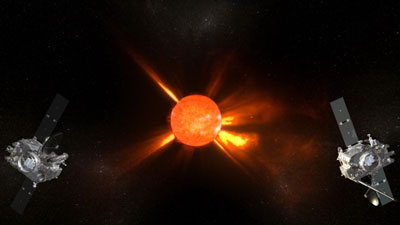More solar physics, pleaseby Taylor Dinerman
|
| Scientists are still not sure exactly what causes CMEs. Nonetheless, a billion tons of energized particles traveling at over million kilometers an hour creates powerful effects. |
The Sun is not only a potential source of electrical energy for the world economy, but it obviously influences climate change; the degree of influence, though, is open to debate. NASA along with other space agencies has maintained a fairly robust, if not generous, stream of funding for solar physics research over the past decade or more. STEREO is an example of what can be done on what is, for a space mission, a fairly modest budget of $540 million for the two spacecraft, the Delta 2 launcher, the first two years of operations, and three years of analysis.
Each of the two spacecraft is equipped with four instrument packages. The Sun Earth Connection Coronal and Heliosphereic Investigation (SECCHI) will study CMEs in three dimensions using an extreme ultraviolet imager, a pair of white light coronagraphs, and a heliosphereic imager from the UK. The STEREO WAVES instrument will measure radio waves produced by electrons traveling along the magnetic field lines of the interplanetary magnetic field. It will also study radio disturbances caused by CMEs and will be run from the Paris Observatory with some help from the Goddard Space Flight Center.
IMPACT (In Situ Measurements of Particles and CME Transients) will sample the 3-D distribution and provide plasma characteristics of solar energetic particles. PLASTIC (PLAsma and SupraThermal Ion Composition) will study the protons, alpha particles, and heavy ions that are part of CMEs. Together these pairs of instruments will give scientists their best and most comprehensive look at the composition and behavior of CMEs that has so far been available. They may eventually lead to the ability to predict when a CME is about to occur.
For future explorers this ability will be invaluable, and in fact it could be the difference between life and death. Certainly the effort that NASA is putting into solar physics is going to pay off enormously when the time comes and they are able to understand the basic causes of space weather and the Sun’s behavior.
By launching this mission now, during low point in the Sun’s 11-year activity cycle, NASA is allowing the satellites and their Earth-based teams to get used to the system’s behavior and operational potential. One can confidently expect that if the spacecraft reach their intended positions, in Earth-leading and Earth-trailing orbits courtesy of simple lunar swingbys, they will last at least a decade. The example of SOHO—which has overcome numerous problems and has now been working successfully for the last ten years—shows what can be done. When the next solar max begins in 2012 the STEREO spacecraft science teams will have had about six years of experience and the instruments will be as perfectly calibrated as possible.
Human space explorers are not the only ones who will benefit from this research. Climate research scientists will also be able to use the new and much deeper understanding of solar activity to study the ways that this effects the Earth’s changing climate. As part of the contentious debate over global warming most scientists believe that there are natural causes as well as human ones. The core of the debate is over how much of each is responsible for the observable climatic phenomena.
The Living With a Star program will not, by itself, provide the answers to these questions, but it does give the scientific community an ever-expanding base of knowledge about the Sun and its effects not just on the Earth but also on the rest of the solar system. In 2008 NASA plans to launch the Solar Dynamics Observatory (SDO), which in some ways will pick up from where SOHO will be leaving off, giving researchers in this area even more data.
| NASA’s solar physics program is not just a wise investment for space exploration and for climate science, but also one of the essential tools to promote successful global economic development in the second half of this century. |
The US government continues to pay for some fantastic scientific tools to help scientists study the Sun. One potential problem is that there are simply not enough specialists in solar physics in the US science community to take advantage of this rich flow of information. No doubt this will data be shared with international researchers through the International Living With a Star (ILWS) program. Another thing that would be helpful would be for the US government to provide grants for undergraduates to begin to concentrate on this discipline. In five or six years, when the best and most dedicated of them are ready to enter the postdoctoral phase of their studies, they’ll be prepared to take full advantage of the information these spacecraft are going to be sending back to Earth.
Over the next thirty or forty years the Earth is going to need vast new supplies of energy, including liquid fuels for transportation as well as electricity. As China and India develop into advanced economies their demand for reliable non-polluting supplies of power is going to be unimaginably huge. Space-based solar power will almost certainly have to be part of the answer. The potential of these systems can only be fulfilled if we have a far better understanding of our local star than we do now. Doing the scientific research in the short term will enable us to build the technology in the longer term.
NASA’s solar physics program is not just a wise investment for space exploration and for climate science, but also one of the essential tools to promote successful global economic development in the second half of this century. The size of the current investment is adequate, but only just. It is urgent to begin training a new generation of solar scientists who will take this field of study to a far higher level.
